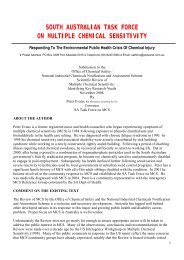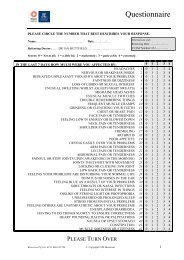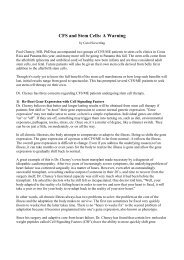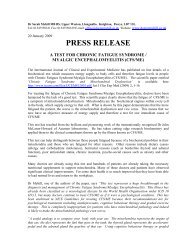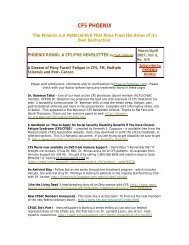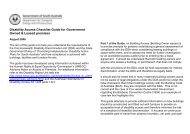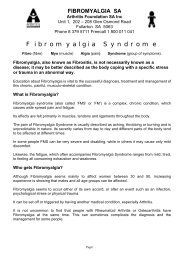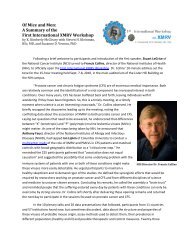38 F. Atzeni et al.lalanine (17), and collagen cross links, and particularly,a reduction in the ratio of pyridinoline to deoxypyridinolineas well as decreased levels of hydroxipyroline(18) were also found. Neopterin hasbeen suggested as an inflammation marker, whichhas an inversely proportional relationship with L-tryptophan availability. Other studies showed lowserum levels of 5-HT in FM patients compared toboth healthy controls and patients with rheumaticdiseases such as RA. These studies provide indirectevidence supporting the alteration of 5-HT metabolismin FM subjects. In a recent study, FM patientsexhibited a tendency to have lower serotonin levelsthan patients with RA and healthy controls; butthe variation of serotonin levels within the diseasegroups is too broad to differentiate FM from otherconditions, especially depression (19). There is alsoevidence to suggest that FM patients may havealterations in the expression of 5-HT transportersdue to a transcriptional polymorphism in the regionthat could lead to an increase of the same transcriptionalregion (20). Another study has suggestedthat an alteration of the growth hormone(GH), an indirect modulator of the immune systemthat interacts with the hormonal system, seems toprotect the body from the immunosuppressive effectsof glucocorticoids during stress (21) andfavours IGF1-mediated muscle repair. Alteredserum cortisol and melatonin levels were found;these hormone secretions are closely associatedwith the circadian rhythms. The study also foundalterations of 5-HT, somatomedin C, calcitoningene-related peptide, calcitonin and cholecystokininwhich are possible indicators of FM widespreadpain (22). Studies conducted on FM patientsshowed an increase in plasma levels of IL-6 and IL-8 compared to healthy controls, an increased productionof IL-1 and TNF-alpha, and a reduced productionof IL-2 and IFN-alpha, which highlights animmune activation and a down-regulation of theHPA. A study showed an increase in plasma IL-10,IL-8 and TNF-alpha in FM patients independent ofthe presence of psychiatric comorbidity; this supportsthe hypothesis of an activation of the immunesystem (23). Abnormal levels of ACTH, 5-HT,IGF-1 and FT4 were found, which suggests an alterationof the endocrine system in this disease(14). The role of free radicals in FM is controversial,as this could suggest that FM is also an oxidativedisorder; studies have shown high levels ofmalondialdehyde, markers of oxidative damage,and low levels of superoxide dismutase, an intracellularantioxidant (24) in FM.UrineThe stress factor is probably crucial in this conditionand alterations of the urinary corticotropin-releasingfactor (CRF)-L1, catecholamine, cortisol,with the haplotypes of catecholamine COMT gene(25) were recently found; as in the serum, crosslinksof collagen, a reduction in the ratio of pyridinolineto deoxypyridinoline and decreased levels ofhydroxyproline (18) were found in the urine.Cerebrospinal fluidIn FM subjects, substance P levels increase in cerebrospinalfluid and this event leads to the releaseof IL-6. Substance P induces the production of IL-8, a pro-inflammatory cytokine, which stimulatesthe passage of neutrophils through the vascularwalls. Altered levels of serotonin and increasedcorticotropin-releasing hormone (CRH) and a poolof proteins (alpha-1-macroglobulina, keratin 16,orosomucoide, amyloid precursors etc.) were alsofound in the cerebrospinal fluid of FM patients(26). Among FM patients, pain, but not fatigue,was associated with the concentration of CRF inthe cerebrospinal fluid (27).These data support the hypothesis that abnormalitiesin the stress response are associated withFM pain. In FM subjects, a reduction of glial cellderivedneurotophic factor was also found (28);this result could be related to the role of this neurotophicfactor in preventing and reversing abnormalitiesthat develop in chronic pain conditions.Somatostatin levels appear to be reduced in thecerebrospinal fluid of FM patients and significantlycorrelated with reduced levels of neurotophicfactor.Isolated cellsAlterations of the immune cells have been studiedin FM patients, highlighting an abnormal lymphocyteand cytokine (IL-6-8-10 TNF-alpha) responserelated to FM. Specifically, the number of T lymphocytesand the immunoglobulin M level appearto be altered, and the number of natural killer cellsappears to be reduced. In FM patients, reduced activationof T lymphocytes was also found. The cellreceptors, especially the peripheral benzodiazepinereceptor (PBR), the 5-HT receptors and the 5-HTre-uptake system were altered. Studies conductedon platelets have shown a reduced receptor densityand functionality of 5-HT and its carrier, whichwere identified by lower 5-HT re-uptake rate fromthe synaptic cleft (29). Other research has shown
The evaluation of the fibromyalgia patients 39an up-regulation of PBR, also related to the severityof illness (30). In the platelets of FM patientsincreased intracellular concentrations of calciumand magnesium ions and decreased ATP levelswere also found. In a recent study (31), a comparisonwas made between FM patients, subjects withcomplex regional pain syndrome (CRPS) andhealthy controls regarding the influence of pain onsubpopulations, lymphocyte number, and the ratioof Th1 to Th2 cytokine in T lymphocytes. The lymphocytenumber did not differ between groups, butthere was a significant reduction of cytotoxic CD8+lymphocytes in FM and CRPS patients.TissuesIn skin biopsies an increase of activated mast cellshas been observed (25). It appears that muscle tissuedoes not exhibit alterations at the cellular level;and while the data appear inconsistent, inflammatoryinfiltrates have not been found. The skin ofFM patients shows unusual patterns of unmyelinatednerve fibers as well as Schwann cells; if theseresults are replicated in a larger study, these abnormalitiesmay contribute to the lower pain thresholdof FM subjects (32).INSTRU<strong>ME</strong>NTAL STUDIESStudies that employ existing or innovative testingdevices or methodologies are usually negative, andthese testing methodologies are not recommendedfor purposes of screening or diagnosis (33); however,imaging tests can be used to exclude concomitantillnesses that could resemble FM.The following overview of comorbidities highlightsthe need for improved instruments for accurate assessmentof FM. Environmental factors can influenceboth the development of FM and a number of“stressors” that are temporally correlated with theonset of the syndrome, including trauma, infections(e.g., hepatitis C virus, HIV, and Lyme disease),emotional stress, catastrophic events (e.g.,war), autoimmune diseases and other pain conditions(34, 35). FM has been reported to coexist in25% of patients with RA, 30% of patients withSLE and 50% of patients with Sjogren’s syndrome(36-38).The most common rheumatic diseases that couldoverlap and be confused with FM are: osteoarthritis(OA), RA, ankylosing spondylitis (AS),polymyalgia rheumatica (PMR), SLE, Sjogren’ssyndrome, osteomalacia, polymyositis.OA is observed most often in people over age 50(most of them are asymptomatic); OA, togetherwith FM, is among the most prevalent (7%)rheumatic syndromes in clinical practice (39). OAcan be confused with FM because it causes arthralgiasof the whole body and could be associatedwith significant limitation of activity. It has a clearpredilection for certain joints, in particular, the firstcarpometacarpal joints, cervical and lumbar spine,hips, knees and metatarsophalangeal joints (40).Radiographically, OA has classic changes that includeosteophyte formation, joint space narrowing,subchondral sclerosis, and subchondral cysts (41).It may seem reasonable to study the painful regionon radiograph, but radiographs are not necessarilycorrelated with clinical symptoms and must be interpretedcorrectly in the clinical context.RA is an inflammatory arthritis; the patients presentwith inflammatory symptoms. The historicalevaluation and the physical examination are fundamentalto determine, for example, if real synovitisis present. The radiographic manifestationsof RA have been well described (marginal erosions,joint space narrowing, joint destruction), and disease-specificalterations that can be seen during theclinic visit (e.g., soft tissue swelling, deformities,subluxations) could be partially found on radiographs.In fact, it takes months or years to developthese alterations, which emphasizes the importanceof developing new instrumental assessmentsthat will facilitate early diagnosis of RA. Magneticresonance imaging (MRI) is the gold standard forconfirming the diagnosis of RA, but is too expensivefor normal management. Muscoloskeletal ultrasonographyis easy to perform, can be repeatedwithout X-ray exposure risks for patient, and representsthe best compromise between cost and result(42-44). The ultrasonography evaluation of thepatient could help the clinician to identify the elementsfor RA or FM diagnosis.AS usually begins with an insidious onset of chronicinflammatory back pain symptoms in adolescenceor early adulthood (45). AS can be easilymistaken for FM, because both diseases occur inyoung patients who may have constitutional symptomssuch as malaise, fatigue and impaired sleep(45). The hallmark of AS is sacroiliitis as identifiedradiographically via conventional pelvic X-ray, although this condition may not be evident inthe early stages of the illness (46). Sacroiliitis doesnot occur in FM, though, so its presence is fundamentalin distinguishing AS from FM. Recent reportsindicate that the role of MRI has become
- Page 2 and 3: 2 P. Sarzi-Puttini et al.The meetin
- Page 4 and 5: 4 M. Cazzola et al.(2). In the earl
- Page 6 and 7: 6 M. Cazzola et al.enough to meet F
- Page 8 and 9: 8 M. Cazzola et al.Table I - Charac
- Page 10 and 11: 10 M. Cazzola et al.Table IV - Cond
- Page 12 and 13: 12 M. Cazzola et al.teria, three su
- Page 14 and 15: 14 M. Cazzola et al.tients with a n
- Page 16 and 17: 16 G. Cassisi et al.The cardinal fe
- Page 18 and 19: 18 G. Cassisi et al.StiffnessIn FM
- Page 20 and 21: 20 G. Cassisi et al.Autonomic and n
- Page 22 and 23: 22 G. Cassisi et al.Associated symp
- Page 24 and 25: 24 G. Cassisi et al.46. Coleman RM,
- Page 26 and 27: 26 S. Stisi et al.sensitization,”
- Page 28 and 29: 28 S. Stisi et al.Sum oflife-events
- Page 30 and 31: 30 S. Stisi et al.trols, they prese
- Page 32 and 33: 32 S. Stisi et al.stress, obtained,
- Page 34 and 35: 34 S. Stisi et al.50. Harris RE, Cl
- Page 36 and 37: ORIGINAL ARTICLEReumatismo, 2008; 6
- Page 40 and 41: 40 F. Atzeni et al.clearer and it m
- Page 42 and 43: 42 F. Atzeni et al.healthy control
- Page 44 and 45: 44 F. Atzeni et al.and/or verbal (e
- Page 46 and 47: 46 F. Atzeni et al.for study purpos
- Page 48 and 49: 48 F. Atzeni et al.mimics of fibrom
- Page 50 and 51: ORIGINAL ARTICLEReumatismo, 2008; 6
- Page 52 and 53: 52 P. Sarzi-Puttini et al.A larger
- Page 54 and 55: 54 P. Sarzi-Puttini et al.from 1966
- Page 56 and 57: 56 P. Sarzi-Puttini et al.rational,
- Page 58 and 59: 58 P. Sarzi-Puttini et al.49. Toffe
- Page 60 and 61: 60 R. Casale et al.cal exercise and
- Page 62 and 63: 62 R. Casale et al.definition of
- Page 64 and 65: 64 R. Casale et al.are more or less
- Page 66 and 67: 66 R. Casale et al.trol associated
- Page 68 and 69: 68 R. Casale et al.32. Lewit K. The
- Page 70 and 71: ORIGINAL ARTICLEReumatismo, 2008; 6
- Page 72 and 73: 72 L. Altomonte et al.In a clinical
- Page 74 and 75: 74 L. Altomonte et al.Table II - We
- Page 76 and 77: 76 L. Altomonte et al.treatments de



